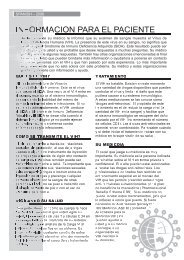B Positive – all you wanted to know about - ASHM
B Positive – all you wanted to know about - ASHM
B Positive – all you wanted to know about - ASHM
You also want an ePaper? Increase the reach of your titles
YUMPU automatically turns print PDFs into web optimized ePapers that Google loves.
Appendix 1<br />
Hepatitis B Fact sheet <strong>–</strong> for people living with chronic infection<br />
What is hepatitis B?<br />
Hepatitis means inflammation of the liver. it may be caused by infection with a virus, such as the<br />
hepatitis b virus. When hepatitis b virus enters the body it travels <strong>to</strong> the liver, where it lives and<br />
multiplies in liver cells. the presence of the virus in the liver stimulates the immune system <strong>to</strong> kill it.<br />
unfortunately, it is the body’s immune response, not the virus, that causes most of the inflammation<br />
and damage <strong>to</strong> the liver.<br />
the impact of hepatitis b infection depends on a person’s age when they become infected. infants<br />
with hepatitis b infection almost always develop a long-term (chronic) infection, whereas people<br />
who get the infection as adults have a 95% chance of clearing the virus from their body.<br />
Many people with hepatitis b do not get sick and do not <strong>know</strong> they have hepatitis b virus infection.<br />
some people experience tiredness, nausea (feeling sick) and jaundice (yellowing of the eyes and<br />
skin). infants rarely develop symp<strong>to</strong>ms of infection. <strong>about</strong> 50% of adolescents and adults develop<br />
jaundice when they first get the infection, which is c<strong>all</strong>ed acute hepatitis b.<br />
Chronic hepatitis B<br />
a person is diagnosed with chronic hepatitis b when they have the virus infection for longer than<br />
6 months (confirmed through blood tests). chronic hepatitis b develops in approximately 5%<br />
of adults, some children and most infants with the infection. People with chronic hepatitis b are<br />
likely <strong>to</strong> have a lifelong infection, and although they gener<strong>all</strong>y remain in good health, they have an<br />
increased risk of developing serious complications, such as cirrhosis (scarring of the liver) and liver<br />
cancer. importantly, people with chronic hepatitis b have the potential <strong>to</strong> spread the infection if<br />
they do not follow some simple precautions.<br />
How is hepatitis B spread?<br />
Hepatitis b is spread when blood and other infected bodily fluids (including saliva, semen and vaginal<br />
fluids) enter the bloodstream either through a break in the skin or through mucous membranes.<br />
Hepatitis b virus can be spread as follows:<br />
� a pregnant woman with hepatitis b infection can transmit the infection <strong>to</strong> her baby at the time<br />
of birth—this is the most common way the virus is spread in developing countries around the<br />
world<br />
� Vaginal, anal or oral sex without a condom<br />
� reusing injecting equipment<br />
� tat<strong>to</strong>oing or body piercing<br />
� close contact, including the sharing of <strong>to</strong>othbrushes, razors, nail files or other personal items that<br />
may lead <strong>to</strong> the exchange of body fluids<br />
� blood transfusion (donated blood is now screened in most developed countries and so there is<br />
only a very sm<strong>all</strong> risk of infection. receiving a blood transfusion in some areas of the world can<br />
still be extremely risky)<br />
� accidental needlestick injury or splashing of infected blood or body fluids, especi<strong>all</strong>y for health<br />
care workers<br />
� contact sports<br />
10 b <strong>Positive</strong> <strong>–</strong> <strong>all</strong> <strong>you</strong> <strong>wanted</strong> <strong>to</strong> <strong>know</strong> <strong>about</strong> hepatitis b: a guide for primary care providers






